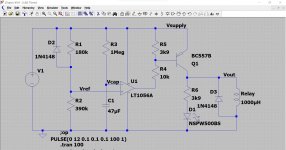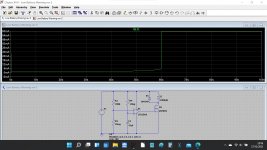Hello all .
I need the help of a specialist in a department based on the following:
I have a voltage ( 12V DC) through which I turn on a lamp (LED) as soon as the voltage enters the lamp it will glow, what I want is to have an electronic circuit that the voltage enters and after a minute of entering the voltage the lamp ( LED) glows. And it stays glowing. In other words, I want to delay the timer for the passage of voltage to the lamp.
Any help thank you.
I need the help of a specialist in a department based on the following:
I have a voltage ( 12V DC) through which I turn on a lamp (LED) as soon as the voltage enters the lamp it will glow, what I want is to have an electronic circuit that the voltage enters and after a minute of entering the voltage the lamp ( LED) glows. And it stays glowing. In other words, I want to delay the timer for the passage of voltage to the lamp.
Any help thank you.
Attachments
I would think a very simple timer circuit would work. There are many designs using for example a 555 timer chip or you could just use a CMOS package of 4 gates (like a CD4011) and simple C/R delay or another simple (maybe best) option is a single opamp to drive the LED and just set a voltage reference on one input (two resistors) and have a C/R delay on the other.
A 555 timer controlling a relay coil can do this. The timing capacitor
would have to be a low leakage electrolytic around 100uF.
If the lamp uses only a small current under 200mA, the 555 may be able
to switch the current directly, without a relay.
would have to be a low leakage electrolytic around 100uF.
If the lamp uses only a small current under 200mA, the 555 may be able
to switch the current directly, without a relay.
thank you my friend . Indeed, I thought of using a comparison or Op Amp operations such as (LM324N) or (LM833)but I lack the scheme to implement it in practice.I would think a very simple timer circuit would work. There are many designs using for example a 555 timer chip or you could just use a CMOS package of 4 gates (like a CD4011) and simple C/R delay or another simple (maybe best) option is a single opamp to drive the LED and just set a voltage reference on one input (two resistors) and have a C/R delay on the other.
Maybe use Riley.A 555 timer controlling a relay coil can do this. The timing capacitor
would have to be a low leakage electrolytic around 100uF.
If the lamp uses only a small current under 200mA, the 555 may be able
to switch the current directly, without a relay.
The opamp would need to be a FET type to get super low input bias currents. Something like a TL071 or TL061 to begin experimenting with.
The cap needs to be low leakage so really a tant. You would have to experiment. The opamp output goes high when the voltage on the cap reaches the voltage set by the divider network. Depending on the opamp you might find the output is not at zero volts (as in the simulation) and that would give a glow from the LED. To stop that just add a series diode to the LED.
This is from a different circuit but it will give you an idea... just look at the part circled in red.

The cap needs to be low leakage so really a tant. You would have to experiment. The opamp output goes high when the voltage on the cap reaches the voltage set by the divider network. Depending on the opamp you might find the output is not at zero volts (as in the simulation) and that would give a glow from the LED. To stop that just add a series diode to the LED.
This is from a different circuit but it will give you an idea... just look at the part circled in red.

thank you my friend .Who is in control of time?The opamp would need to be a FET type to get super low input bias currents. Something like a TL071 or TL061 to begin experimenting with.
The cap needs to be low leakage so really a tant. You would have to experiment. The opamp output goes high when the voltage on the cap reaches the voltage set by the divider network. Depending on the opamp you might find the output is not at zero volts (as in the simulation) and that would give a glow from the LED. To stop that just add a series diode to the LED.
This is from a different circuit but it will give you an idea... just look at the part circled in red.
View attachment 1009176
.Who is in control of time?
All four parts have an influence. In the second circuit R1 and R2 fix the voltage on the + input at about 9 volts (for a 12 volt supply rail). The cap C2 charges via the 1 meg. When the voltage on the cap passes 9 volts the opamp output flips state and lights the LED. So you can see altering any of the values alters the delay.
If you are using high value resistors then you must use a FET opamp.
Can we replace the LED with a relay? Can you explain to me, my friend, why you used the LT1056 JFET Operational Amplifier?Or a slight rearrangement driving the LED from the + rail into the opamp. Note the opamp inputs are now swapped in their function.
View attachment 1009178
It is a pretty generic FET opamp very similar to a TL071. No other reason for picking that one other than it is an included model with LTspice and one I always use when I want a FET opamp.Can you explain to me, my friend, why you used the LT1056 JFET Operational Amplifier?
A TL061 OR TL071 or TL081 would all work the same as would many many others.
I will do it tomorrow and will let you know the details. Thank you dear friend . Thanks everyone. I will put it into practice😉🙂Yes, but an opamp would not drive it directly. We can use a simple transistor to drive a relay. Circuit rearranged again 🙂 to use a small 2N7000 (or7002) FET. Any N channel power FET would be OK.
Have to leave it for now but it will give you some ideas.
View attachment 1009184
If it works in practice, can you help me make the GERBER file?🙂OK, good luck.
https://www.amazon.com/DC12V-Delay-Timer-Second-Socket/dp/B08CV4G9QChttps://www.amazon.com/UCTRONICS-Tachograph-Industrial-Electronic-Experiment/dp/B07BT25J52https://www.amazon.com/UCTRONICS-Enclosure-Automobile-Industrial-Electronic/dp/B08TQTY8MPhttps://www.amazon.com/Automotive-Replacement-Time-Delay-Relays/b?ie=UTF8&node=1573357112V DC versions!! (There is a very common delay-relay for heating/cooling systems but it needs AC, 24V or 120/240V.)....I want to delay the timer for the passage of voltage to the lamp.
Last edited:
You can use this NE555 module solder a 1000uF cap parallel to its 100uF cap and adjust to 60 second delay turn on.

NE555 delay turn on module Amazon.com
NE555 delay turn on module Amazon.com
Last edited:
It works in practice... I just built one to prove it 😉 (on a breadboard) I wanted to be sure a standard cap would be OK and that it would charge OK via a high value resistor. It does seem to do so.If it works in practice, can you help me make the GERBER file?🙂
Here is a final version. The circuit in practice worked fine with TL071's and also some very ancient 741's. The 47uF cap was a good quality Wurth 47uF 16v electrolytic. In practice I got 56 seconds delay for a TL071 and 60 seconds for a 741.
Look at the simulation to see how it works. When the cap voltage Vcap reaches the level of the reference voltage Vref the opamp output goes from high to low. That turns on the PNP transistor which can drive whatever load you want such as an LED and a relay.
The reverse biased diode across the cap discharges the cap at power off and ensure the circuit works correctly if you immediately switch it back on again. The diode across the relay is to supress back emf.
R5 (in the real circuit) was not actually needed but in the simulation it is. This resistor ensures the transistor is fully off if the opamp output does not quite reach the positive rail.
Gerbers are something you will have to get someone else to help with 🙂 The circuit is so simple it could be built on stripboard. If I did a PCB I would just do it on the fly and etch it.
I'll also attach the simulation file.


Attachments
- Home
- Amplifiers
- Power Supplies
- Turn on the lamp LED late to enter the voltage


